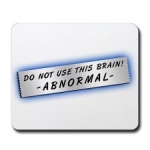It seems that my OSA is far worse during REM than other sleep states. My (untreated) REM AHI is around 60, but given that I have far fewer events in other states and spend more time in them, my total AHI is about 15, I think.
I guess AHI=15 puts me in the mild or maybe moderate category. But it seems like a misleading number. If my AHI during REM is 60, isn't that more severe than AHI=15 suggests?
This is more of a curiosity question, because I'm receiving effective therapy, and the doctor did not balk at prescribing treatment. But it seems to me that people might have a bad problem during REM, and no problem the rest of the night, bringing their AHI lower than 5 or 10 or whatever the Dx cut-off is, yet it seems like they would still need treatment.
I guess what my question is, how is an AHI that varies wildly between various stages of sleep viewed by the sleep industry? Shouldn't they include a variance value along with the mean before tossing people into the mild/moderate/severe categories?
When is OSA mild/moderate/severe?
Re: When is OSA mild/moderate/severe?
Smart docs would actually look at your sleep study, see that your AHI is high in REM and prescribe you an APAP to save your life. My sleep study, like yours, was broken down into AI and HI by sleep stage and body position. I think this is a limitation of the 'home titration' with an APAP - without the EEG, you dont get that infoLoQ wrote:It seems that my OSA is far worse during REM than other sleep states. My (untreated) REM AHI is around 60, but given that I have far fewer events in other states and spend more time in them, my total AHI is about 15, I think.
I guess AHI=15 puts me in the mild or maybe moderate category. But it seems like a misleading number. If my AHI during REM is 60, isn't that more severe than AHI=15 suggests?
This is more of a curiosity question, because I'm receiving effective therapy, and the doctor did not balk at prescribing treatment. But it seems to me that people might have a bad problem during REM, and no problem the rest of the night, bringing their AHI lower than 5 or 10 or whatever the Dx cut-off is, yet it seems like they would still need treatment.
I guess what my question is, how is an AHI that varies wildly between various stages of sleep viewed by the sleep industry? Shouldn't they include a variance value along with the mean before tossing people into the mild/moderate/severe categories?
Re: When is OSA mild/moderate/severe?
Ah this is a tidbit that I was unaware of because I was diagnosed using a Remmer Sleep home study unit and then was given a loaner APAP for titration. I can't complain though something is working my AHI is usually around 2 or lower. I am not sure though if maybe I am missing something or maybe I shouldn't be putting all my eggs in the AHI cart! (oh that's awful).elader wrote:Smart docs would actually look at your sleep study, see that your AHI is high in REM and prescribe you an APAP to save your life. My sleep study, like yours, was broken down into AI and HI by sleep stage and body position. I think this is a limitation of the 'home titration' with an APAP - without the EEG, you dont get that infoLoQ wrote:It seems that my OSA is far worse during REM than other sleep states. My (untreated) REM AHI is around 60, but given that I have far fewer events in other states and spend more time in them, my total AHI is about 15, I think.
I guess AHI=15 puts me in the mild or maybe moderate category. But it seems like a misleading number. If my AHI during REM is 60, isn't that more severe than AHI=15 suggests?
This is more of a curiosity question, because I'm receiving effective therapy, and the doctor did not balk at prescribing treatment. But it seems to me that people might have a bad problem during REM, and no problem the rest of the night, bringing their AHI lower than 5 or 10 or whatever the Dx cut-off is, yet it seems like they would still need treatment.
I guess what my question is, how is an AHI that varies wildly between various stages of sleep viewed by the sleep industry? Shouldn't they include a variance value along with the mean before tossing people into the mild/moderate/severe categories?
_________________
| Humidifier: S9™ Series H5i™ Heated Humidifier with Climate Control |
| Additional Comments: Pressures: 5-13 cm |
Cheers!
Re: When is OSA mild/moderate/severe?
An excellent point! However, when you look at the data from the home studies, you could spot the same concentration of events and know that something bad was going wrong during some stage of sleep. You could always calculate the AHI for the different sections of the timeline just for reference.elader wrote:I think this is a limitation of the 'home titration' with an APAP - without the EEG, you dont get that info
Also, if you include pulse-ox test with the home study, I think you can often tell where REM sleep is by observing the changing heart rate.
I think I have seen some home EEG machine sleep tests. Don't know how those studies compare to lab studies.
- billbolton
- Posts: 2264
- Joined: Wed Jun 07, 2006 7:46 pm
- Location: Sydney, Australia
Re: When is OSA mild/moderate/severe?
The reason that a sleep clinician should review/evaluate the result of any PSG (preferred) or home study (if needs must) is to look at the detail output of the study to form a specific diagnosis, following on form the the initial prognosis that a SDB condition existed. If the specific diagnose confirms OSA as the primary condition, then the clinician will determine what the effective OSA severity is, in view of all the data provided by the PSG... not just the rolled up summary numbers.LoQ wrote:Shouldn't they include a variance value along with the mean before tossing people into the mild/moderate/severe categories?
From your report, this seems to be exactly what your sleep clinician did.
Cheers,
Bill
Re: When is OSA mild/moderate/severe?
I think I would have qualified, anyway.billbolton wrote:The reason that a sleep clinician should review/evaluate the result of any PSG (preferred) or home study (if needs must) is to look at the detail output of the study to form a specific diagnosis, following on form the the initial prognosis that a SDB condition existed. If the specific diagnose confirms OSA as the primary condition, then the clinician will determine what the effective OSA severity is, in view of all the data provided by the PSG... not just the rolled up summary numbers.
From your report, this seems to be exactly what your sleep clinician did.
Perhaps this is more of an insurance query. If a person's AHI is less than 10, would insurance pay for CPAP therapy? In the USA, what are the Medicare rules on this?















